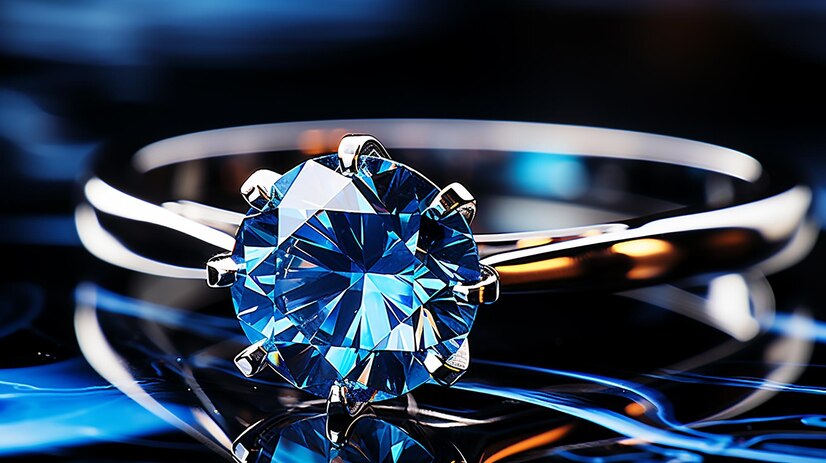
Breaking Down the Debate: Moissanite vs. Diamond
Diamonds have long been considered the ultimate symbol of love and luxury, but in recent years, a sparkling contender has emerged – moissanite. While both gems offer stunning brilliance and allure, they possess distinct characteristics that set them apart. In this comprehensive guide, we’ll delve into the world of moissanite and diamond, exploring their composition, appearance, durability, pricing, and more to help you make an informed decision when selecting the perfect gem for your jewelry.
1. Introduction
What are Moissanite and Diamond?
Before diving into the comparison, let’s understand whats moissanite vs diamond are. Moissanite is a gemstone composed of silicon carbide, originally discovered in a meteor crater by Henri Moissan in 1893. It’s renowned for its exceptional brilliance and affordability. Diamond, on the other hand, is a naturally occurring crystalline form of carbon, formed deep within the Earth’s mantle over billions of years. Its unparalleled hardness and timeless beauty have made it a coveted gemstone for centuries.
2. Composition and Characteristics
Moissanite
Origin and Composition
Moissanite is primarily composed of silicon carbide, a compound known for its exceptional hardness and brilliance. Originally discovered in a meteorite crater, moissanite is now created in laboratories using advanced technology, resulting in gem-quality stones.
Physical Properties
Moissanite exhibits remarkable brilliance, surpassing that of many other gemstones. It boasts a high refractive index, dispersing light with incredible fire and sparkle, akin to that of diamonds.
Diamond
Formation and Composition
Diamonds form deep within the Earth’s mantle under intense heat and pressure. Composed of pure carbon atoms arranged in a crystal lattice structure, diamonds are renowned for their exceptional hardness and durability.
Physical Properties
Diamonds are renowned for their unmatched brilliance and durability. With a hardness rating of 10 on the Mohs scale, diamonds are the hardest natural substance known to man, making them highly resistant to scratching and abrasion.
3. Comparison of Brilliance and Sparkle
Dispersion
Dispersion refers to the ability of a gemstone to split white light into its spectral colors, creating a rainbow effect. Both moissanite and diamonds exhibit impressive dispersion, but moissanite often showcases greater spectral fire due to its higher refractive index.
Fire
Fire, or the dispersion of light into colors, is a key factor in a gemstone’s brilliance. Moissanite’s high dispersion results in vibrant flashes of color, giving it a fiery appearance similar to diamonds.
Brilliance
Brilliance, the overall brightness of a gemstone when viewed under light, is a defining characteristic of both moissanite and diamonds. While moissanite exhibits exceptional brilliance, diamonds are renowned for their unrivaled sparkle and scintillation.
4. Durability and Hardness
Moissanite’s Hardness
Moissanite ranks 9.25 on the Mohs scale of hardness, making it highly resistant to scratching and abrasion. While not as hard as diamonds, moissanite still offers excellent durability for everyday wear.
Diamond’s Hardness
Diamonds are the hardest natural substance, scoring a perfect 10 on the Mohs scale. This exceptional hardness makes diamonds extremely resistant to scratching and ensures their longevity and durability.
Scratch Resistance
Both moissanite and diamonds are highly scratch-resistant, making them suitable for everyday wear in various jewelry settings. However, diamonds, with their superior hardness, offer slightly greater scratch resistance compared to moissanite.
5. Color and Clarity
Moissanite Color Options
Moissanite is available in a range of color grades, from colorless to near-colorless. While most moissanite stones exhibit minimal color, some may display slight hints of yellow or green under certain lighting conditions.
Diamond Color Grading
Diamonds are graded on a color scale ranging from D (colorless) to Z (light yellow or brown). Colorless diamonds are highly prized for their purity and brilliance, while those with visible color may be less valuable.
Clarity Grading
Diamond clarity refers to the presence of internal flaws, known as inclusions, and external blemishes. Diamonds with fewer inclusions and blemishes are graded higher on the clarity scale and command higher prices.
6. Price and Affordability
Moissanite Pricing
One of the key advantages of moissanite is its affordability compared to diamonds. Moissanite typically costs significantly less than diamonds of similar size and quality, lab diamonds, making it an attractive option for budget-conscious consumers.
Diamond Pricing
Diamonds are renowned for their high value and prestige, often commanding premium prices based on factors such as carat weight, cut, color, and clarity. While diamonds can be a significant investment, they are also highly coveted for their timeless beauty and rarity.
7. Ethical and Environmental Considerations
Mining Impact
The mining of natural diamonds can have significant environmental and social consequences, including habitat destruction, water pollution, and human rights abuses. In contrast, moissanite is created in laboratories using sustainable practices, minimizing environmental impact and ethical concerns.
Lab-Grown Options
In response to growing demand for ethically sourced gems, lab-grown diamonds have become increasingly popular. These diamonds are chemically and optically identical to natural diamonds but are created in controlled laboratory environments, offering a more sustainable and ethical alternative.
8. Popularity and Trends
Consumer Preferences
Consumer preferences for moissanite versus diamonds vary based on factors such as budget, personal values, and aesthetic preferences. While diamonds have long been synonymous with luxury and romance, moissanite’s affordability and ethical appeal are gaining traction among modern consumers.
Market Trends
The market for moissanite jewelry is steadily growing, driven by increasing awareness of its benefits and advancements in gemstone technology. However, diamonds remain the preferred choice for many consumers, particularly for engagement rings and other significant milestones.
